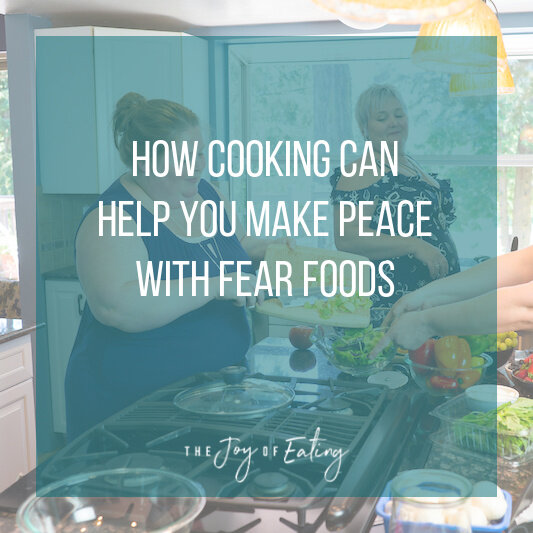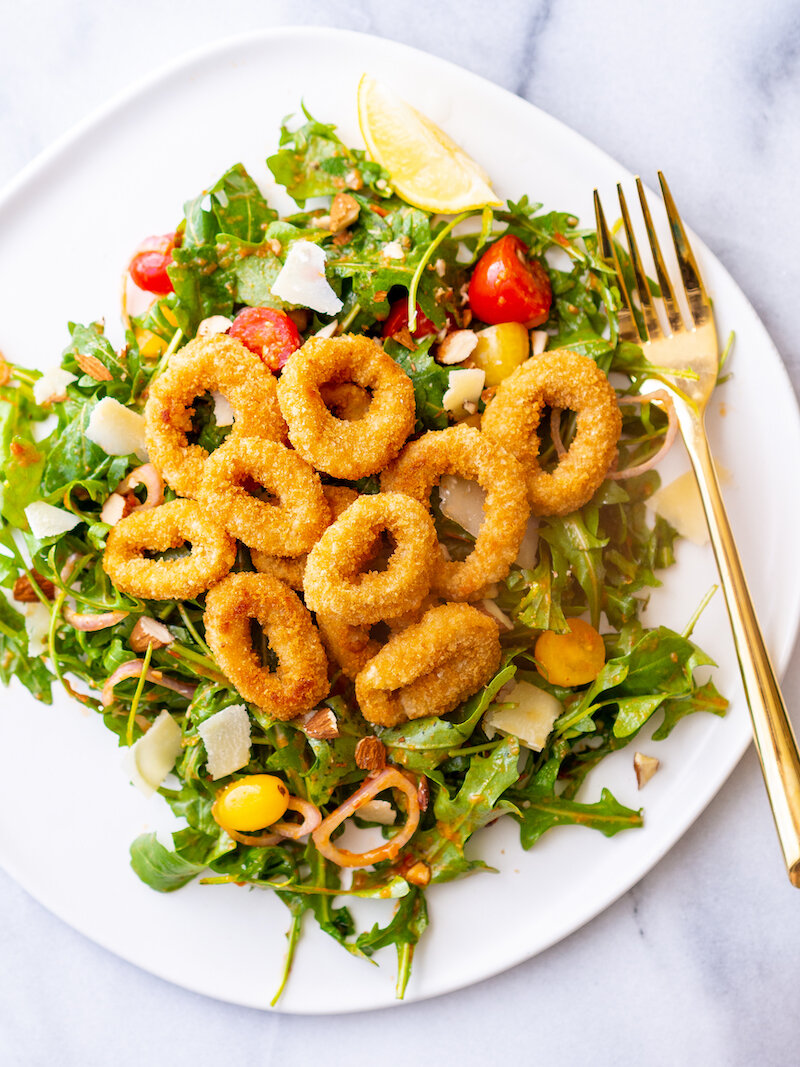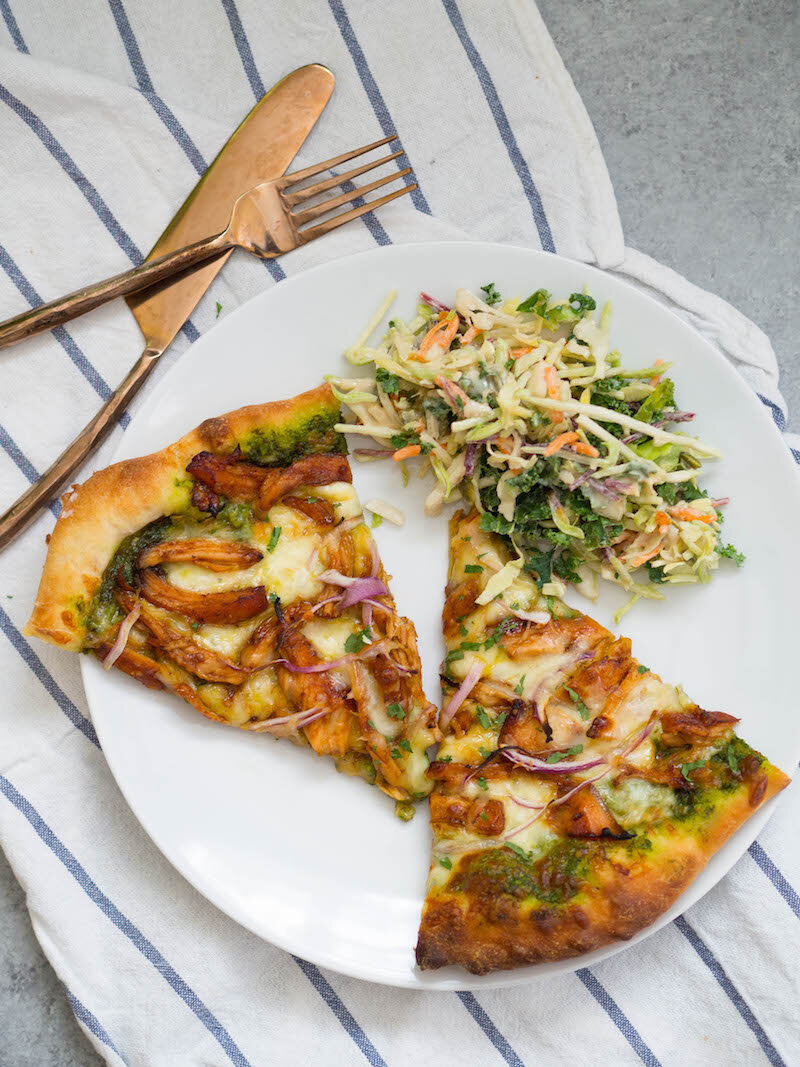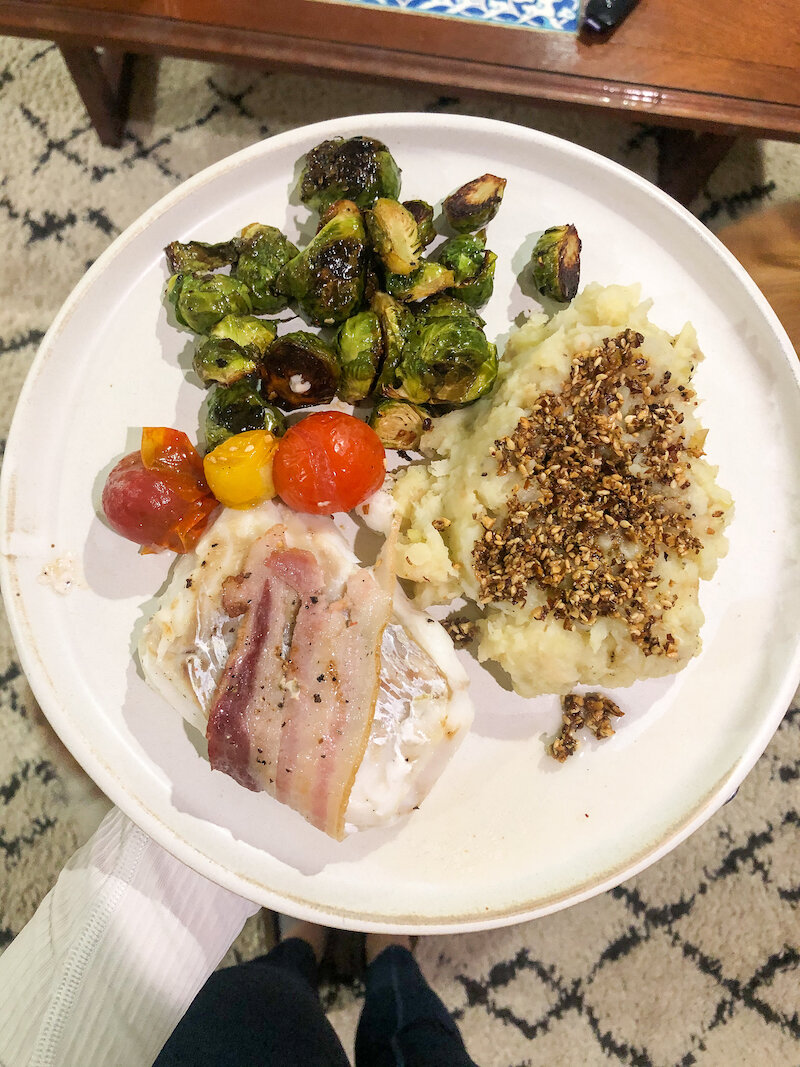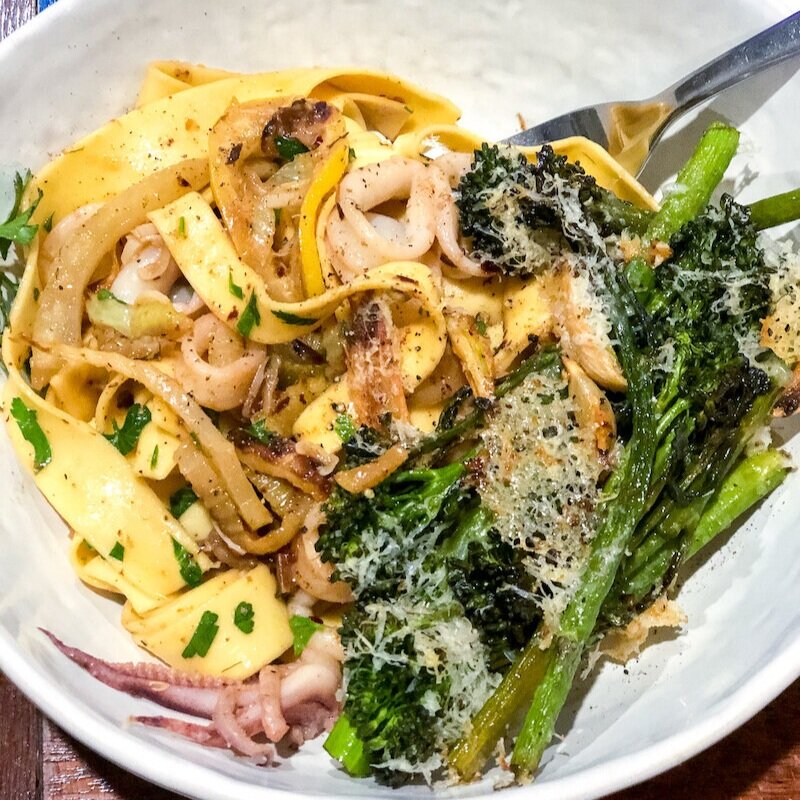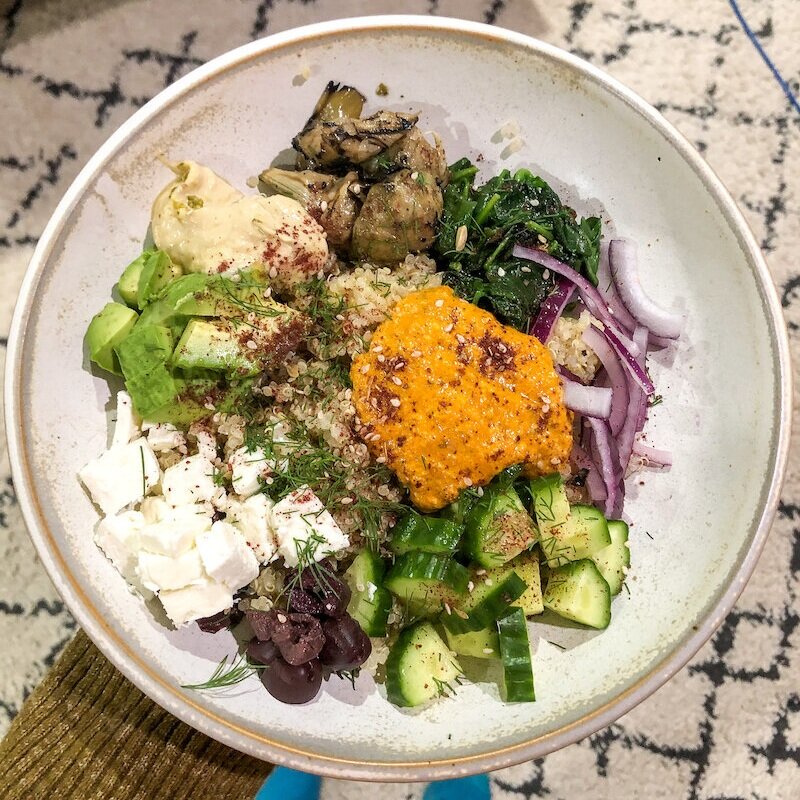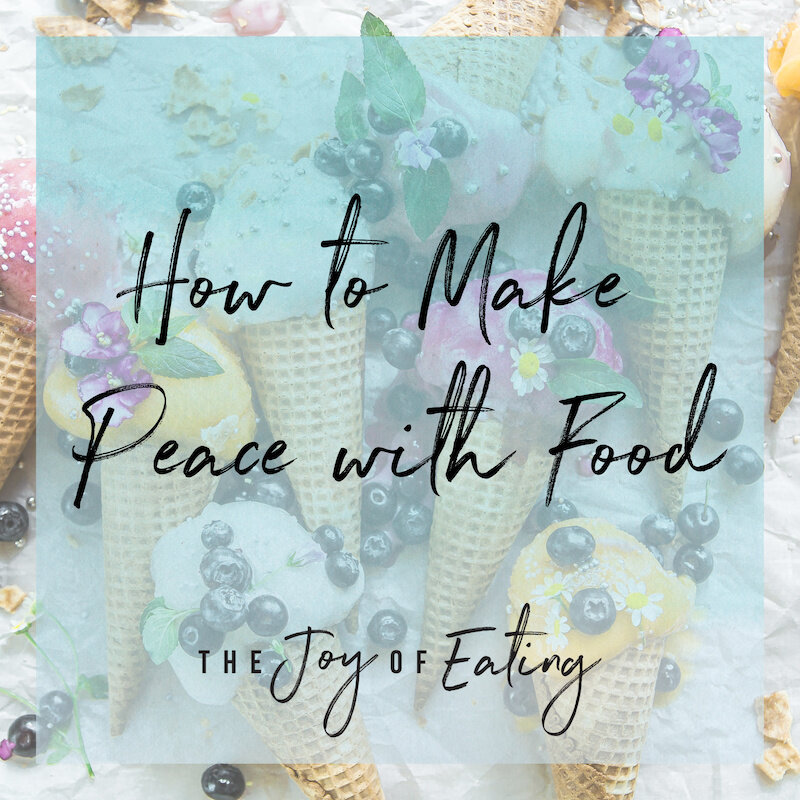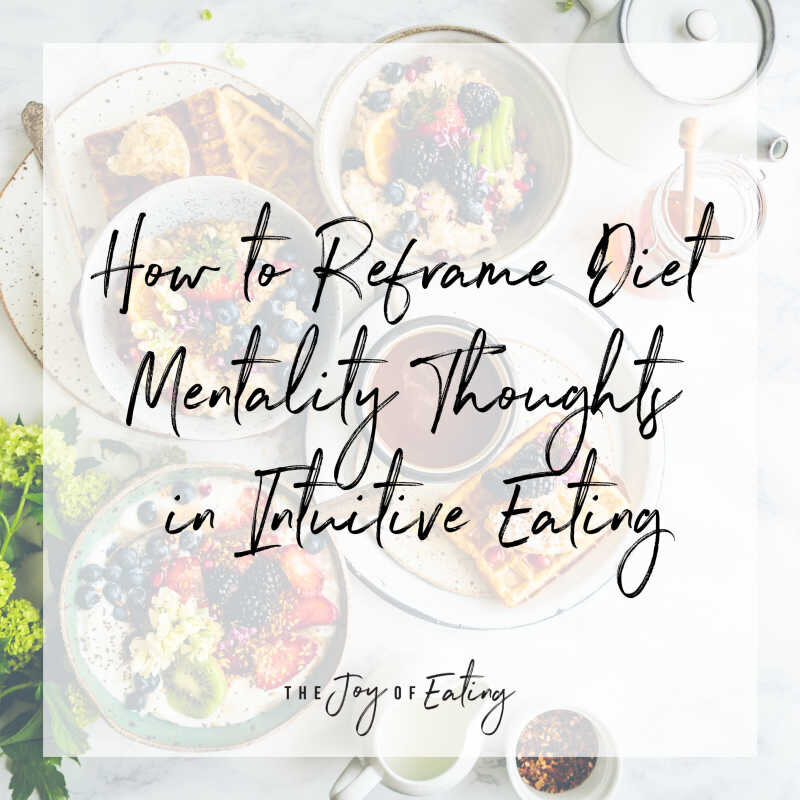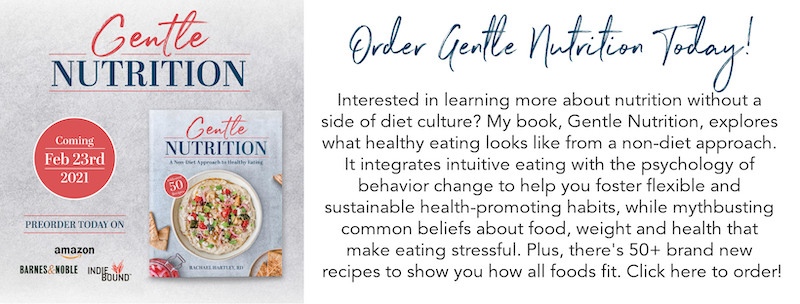How Cooking Can Help You Make Peace With Fear Foods
Need a new idea for making peace with your fear foods? Get in the kitchen and let your creativity shine! This post explores ways of making peace with fear foods through cooking.
As a dietitian who specializes in intuitive eating and the treatment of eating disorders, one thing I’m often working on with my clients is helping them make peace with fear foods.
For anyone who has a history of dieting and disordered eating, fear foods are common. Fear and anxiety around certain foods can develop in a lot of different ways. Sometimes it’s a food that was avoided out of fear of weight gain. Other times it’s a food wellness culture has deemed unhealthy. Many times my clients fear certain foods because they’ve had scary experiences with them in the past, for example certain foods often binged on.
Because the idea of eating these fear foods is anxiety provoking, they do what everyone does when experiencing anxiety - avoid! Fear foods become off-limits foods, which of course just makes the idea of eating that food even more anxiety provoking the next time around. Below is the cycle of anxiety, which I often discuss with my clients in the context of fear foods:
While avoiding fear foods relieves anxiety in the short term, it ramps up anxiety in the long term. Having fear foods can have a major impact on one’s quality of life and relationship with food. It can make social eating extremely anxiety provoking, make it hard to eat pleasurable meals, and when severe, can even impact one’s ability to fuel their body adequately.
Another thing that happens when someone has a fear food is that they loose skills for competently eating the food. They’re either restricting it, or binging/overeating it as a backlash response to restriction. It’s hard to eat a food like a normal human being when you don’t know when you’ll get to eat the food again! These backlash eating experiences reinforce the idea that they don’t have control around the food, and fuels even more fear.
One of many ways I help clients make peace with fear food is by teaching them how to cook with fear foods and incorporate them into balanced meals. Understanding the culinary uses of different foods can help reduce anxiety, and shows how all food has a purpose. Cooking also fosters a connection and a respect with those fear foods, many of which my clients have only eaten when they’re in “binge mode,” not when they’re in a place of wanting to slow down and savor their meal. I find it’s especially helpful when clients learn how to incorporate foods into everyday meals, which also helps to normalize their food choices.
How Cooking Can Help You Make Peace With Fear Foods
Below are some examples of common fear foods, and ideas for how to incorporate them into balanced meals. Preparing a fear food yourself, and incorporating it into a meal that has fat, protein, carbs, and produce, gives you a chance to practice eating your fear food in a normalized way.
Fried Foods
Fried foods are an incredibly common fear food, with a perception of them as being greasy and high in fat and calories. Of course, if we could magically erase fatphobia/fear of weight gain from our brains, a food being high in fat and calories wouldn’t be a scary thing, but alas, that doesn’t exist! To make peace with friend foods, I like to teach my clients how to properly fry food. When the oil is between 350-375 degrees F, it creates a seal between the oil and the food so that very little oil is actually absorbed, AND it makes the fried food super crisp and not at all greasy.
Now, if your kitchen has not the greatest ventilation like mine, deep frying at home might not be do-able without setting off the fire alarm. That’s why I often cook with frozen fried foods, like french fries, chicken tenders or fried seafood. Because most people eat fried foods when they are impulsively getting fast food or are going out to eat or just heating up random frozen fried foods and eating it by itself, I like to teach ways to incorporate them into balanced meals. A couple examples I’ve shared recently in IG using SeaPak (a client of mine) products is this calamari salad and this popcorn shrimp sheet pan dinner. When your brain is categorizing food as “good” and “bad,” it’s easy to craft meals around these binaries. Incorporating fried foods into balanced meals lets you practice “eating in the middle.”
Calamari salad with toasted almonds, shallots, cherry tomatoes and romano dressing!
Pizza
Pizza is a such a fun thing to learn how to make at home! It’s really easy to make with store bought dough, but with all of our quarantine baking, you might want to try my favorite no-knead pizza dough. Making it yourself is a really cool experiment in learning the importance of gluten, the protein in wheat that gives dough its stretchiness. To make pizza feel like a planned meal, it may be helpful to serve it with a side dish, like a fun salad (this chopped salad is a favorite for pizza pairing) or roasted veggies.
Veggie pizza and antipasta salad from my favorite (Columbia level) NY-style pizza takeout
Sweets
Breakfast is a great opportunity to normalize sweets as part of a meal. Pair a breakfast sweet, like a muffin or cinnamon roll, with fruit and scrambled eggs for a balanced meal. Because most of the time sweets are eaten alone, as snacks or at night, it can be an eating situation where there is more vulnerability to binging. Incorporating them at breakfast lets you build comfort with sweets in a way that often feels safer for those who have a history of binging eating with sweets.
Bacon
Bacon is such a delicious flavoring ingredient! I like to saute a couple pieces of chopped bacon and render the fat to cook vegetables in, for example green beans or greens, like this bacon braised mustard greens recipe. Crumbled bacon is also one of my favorite types of “soup bling,” fun, tasty garnishes you can add to soups to dress them up. This spinach apple soup recipe is a great example! I keep extra bacon rolled up fruit roll-up style in the freezer so I can pull some out as needed for cooking.
Bacon wrapped cod with roasted veggies and mashed potatoes (topped with dukkah seasoning)
Mac and Cheese
One way to make peace with mac and cheese, whether it’s homemade or from a box, is to serve it as the starch side in a commonly eaten meal. For example, if salmon, broccoli and quinoa is a go to meal, replace the brown rice with boxed or homemade mac and cheese. This recipe for Poole’s Diner mac and cheese is my favorite “fancy” version, but for an easy weeknight mac and cheese, but this stovetop mac and cheese recipe is my favorite weeknight version (the American cheese is KEY).
Pasta
Just like with mac and cheese, you can serve pasta as a side dish in one of your go to meals. I also like to teach clients how to make pasta dishes that contain all the components of a balanced meal - fat, protein, and produce along with pastas carbs. By including these different components, it can help you eat it in a way that’s more attuned with your hunger and fullness cues. This simple mushroom and white bean pasta or mustard green and sausage orecchiette are great examples!
Calamari pappardelle with caramelized fennel and parmesan roasted broccoli - a fancy dinner I made!
Cheese
As most readers of my blog already know, cheese is my absolute favorite food. One way I like to help clients make peace with cheese is teaching them how to use it as a flavoring ingredient in cooking. Try roasted broccoli with parmesan (I have a great recipe in my book!), goat cheese crumbled into pasta, sharp cheddar over baked or roasted potatoes, or feta cheese crumbled over a grain bowl.
The BEST quinoa grain bowl, topped with diced avocado, hummus, marinated artichokes, sauteed spinach, romesco, red onion, cucumber, kalamata olives and FETA!
I hope this post gives you some ideas and inspiration for getting brave in the kitchen! If you’re feeling afraid of certain foods, make friends with those fear foods by tapping into your creative, culinary side! Feel free to share any other ideas for making peace with fear foods in the kitchen in the comments.

